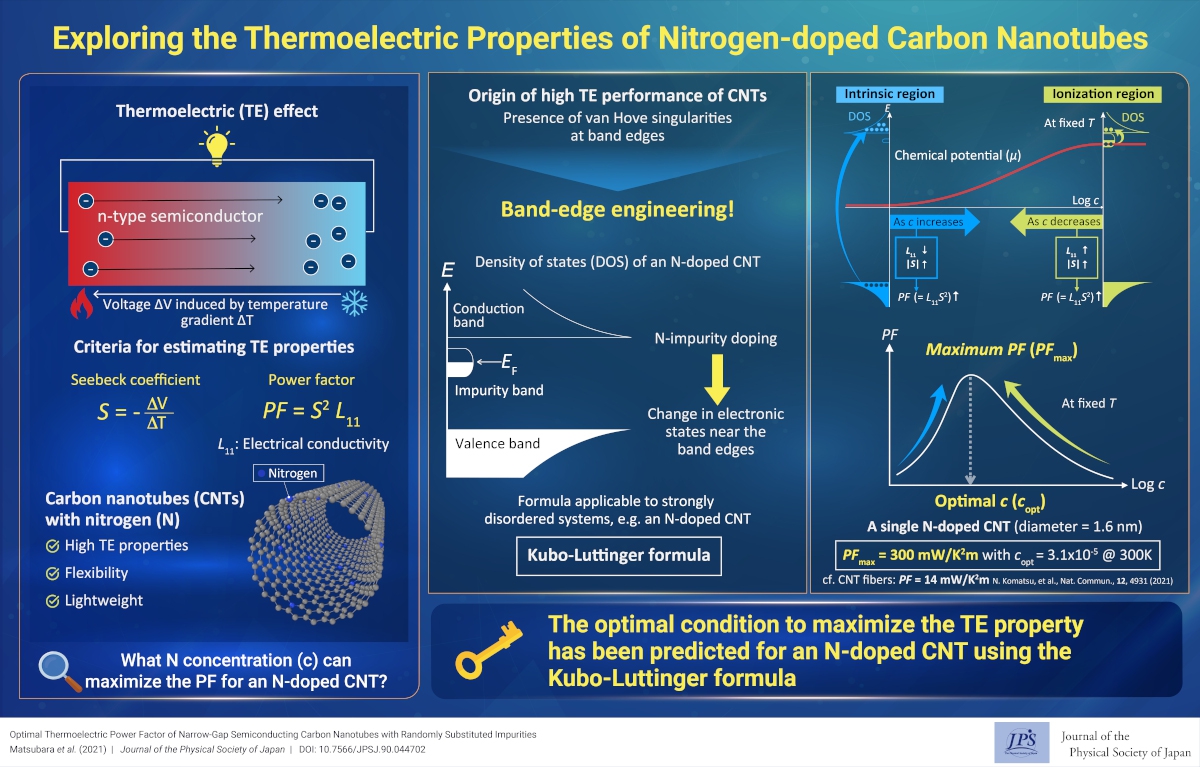Exploring the Thermoelectric Properties of Nitrogen-doped Carbon Nanotubes
© The Physical Society of Japan
This article is on
Optimal Thermoelectric Power Factor of Narrow-Gap Semiconducting Carbon Nanotubes with Randomly Substituted Impurities
J. Phys. Soc. Jpn.
90,
044702
(2021)
.
A semiconducting carbon nanotube doped with an optimal concentration of nitrogen delivered a thermoelectric power substantially higher than that delivered by commercial Bi2Te3 alloys.

Thomas Johann Seebeck discovered the thermoelectric (TE) conversion from heat to electrical energy just 200 years ago. Recently, high-performance TE materials have attracted research interest as energy-harvesting technologies. Most of the experimentally discovered TE materials are impurity-doped semiconductors i.e., disordered systems. High-TE effects are expected near the band edge in the impurity-doped semiconductors, where the electronic states are under the influence of strong impurity scattering not properly treated by the conventional Boltzmann transport theory (BTT). Therefore, it is necessary to develop a sophisticated theory beyond BTT. Recently, the authors (T.Y. and H.F.) have alleviated this drawback using the linear response theory (Kubo–Luttinger formula) in conjunction with the thermal Green's function technique [1–3].
The TE linear response theory was successfully applied to nitrogen-doped semiconducting carbon nanotubes (N-CNTs) in the present study. The N-CNTs functioned as lightweight, flexible, and high-performance TE materials. The power factor, PF (=L11S2), was dependent on the nitrogen concentration, c (up to 10-2), per unit cell of a CNT at various temperatures. The electrical conductivity and Seebeck coefficient were designated as L11 and S, respectively. The PF increased with a decrease in c at 300 K. When cdecreased to less than the optimal impurity concentration, copt (= 3.1×10-5), the PF started to decrease. This behavior was explained based on L11 and S, considering the c-dependence of the chemical potential, μ. The μ at c = 10-3located below the donor level formed via nitrogen doping, and the electrons were thermally excited from the donor level to conduction band. The μ level shifted downward with a decrease in c owing to a decrease in the net carrier density of the N-CNTs. Here, |S| increased with a decrease in c. A decrease in c, corresponding to a decrease in the rate of scattering by the impurities, was accompanied by an increase in L11owing to the electrons in the conduction band. Consequently, the PFincreased with a decrease in c. A further lowering of c promoted the asymptotic approach of μ toward the center of the band gap owing to the thermally excited holes. The holes contributed to an increase in L11; however, |S| decreased rapidly because the hole contribution to S cancels out the electron contribution to S. Therefore, the PF started to decrease below copt. These results facilitated successful estimation of the optimal nitrogen concentration to maximize the PF at various temperatures. A PF of 0.30 W/K2m was obtained for copt at 300 K, which is significantly higher than the PF of commercial Bi2Te3alloys. These theoretical predictions will facilitate the development of new materials with optimal TE performances.
(written by M. Matsubara on behalf of all authors)
References
[1] T. Yamamoto and H. Fukuyama, J. Phys. Soc. Jpn. 87, 024707 (2018).
[2] T. Yamamoto and H. Fukuyama, J. Phys. Soc. Jpn. 87, 114710 (2018).
[3] M. Ogata and H. Fukuyama, J. Phys. Soc. Jpn. 88, 074703 (2019).
Optimal Thermoelectric Power Factor of Narrow-Gap Semiconducting Carbon Nanotubes with Randomly Substituted Impurities
J. Phys. Soc. Jpn.
90,
044702
(2021)
.
Share this topic
Fields
Related Articles
-
Qualitative Changes in Kinetic Pathways Driven by Hydrodynamic Interactions in Dense Colloidal Suspensions
Cross-disciplinary physics and related areas of science and technology
Statistical physics and thermodynamics
Structure and mechanical and thermal properties in condensed matter
2025-4-18
Even in dense colloidal suspensions, where long-range hydrodynamic interactions are screened, near-field hydrodynamic interactions qualitatively influence the selection of kinetic pathways.
-
Exploring the Vibrant Interplay of Machine Learning and Physics
Cross-disciplinary physics and related areas of science and technology
Electron states in condensed matter
Elementary particles, fields, and strings
Mathematical methods, classical and quantum physics, relativity, gravitation, numerical simulation, computational modeling
Statistical physics and thermodynamics
Superconductivity
2025-3-13
This Journal of the Physical Society of Japan Special Topics edition explores how physics and machine learning complement each other and can solve unresolved problems in physics.
-
A Unified Theory of Topological Hall Effect
Electronic transport in condensed matter
2025-3-6
This paper presents a unified theoretical description for the topological Hall effect, covering the entire region from strong- to weak-coupling, extending its picture beyond the Berry phase.
-
Excitonic Insulators: Challenges in Realizing a Theoretically Predicted State of Matter
Electron states in condensed matter
Electronic transport in condensed matter
2025-3-3
The realization of an excitonic insulator can help in the establishment of a new electronic state in condensed matter physics, one that has the potential to exhibit novel electric, magnetic, and optical responses beyond those of conventional materials.
-
Bayesian Insights into X-ray Laue Oscillations: Quantitative Surface Roughness and Noise Modeling
Measurement, instrumentation, and techniques
Structure and mechanical and thermal properties in condensed matter
2025-2-14
This study adopts Bayesian inference using the replica exchange Monte Carlo method to accurately estimate thin-film properties from X-ray Laue oscillation data, enabling quantitative analysis and appropriate noise modeling.




